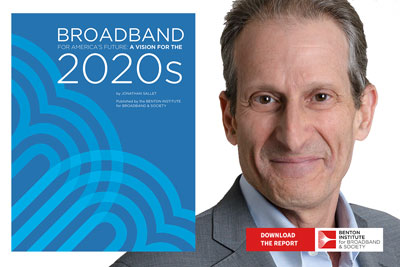A Vision for the 2020s: Access to Broadband in the Next Decade

American democracy, like any democracy, requires the freedom to speak. But American democracy has always recognized the corollary: the strength of speech rests on access to communications networks. From the Post Office, to the telegraph, the telephone, and broadband, governmental action of various stripes has helped connect Americans to each other.
The Benton Foundation serves that mission. Our goal: To bring open, affordable, high-capacity broadband to all people in the U.S. to ensure a thriving democracy in order to deliver new opportunities and strengthen communities to bridge our divides.
The challenge of public policy is always to maintain fundamental goals with an eye towards changing conditions. And for broadband, the times are changing. Fiber extensions, municipal broadband, and prospects of 5G and fixed wireless broadband ensure that the communications infrastructure of the next decade will not be the same as today.
That is why the Benton Foundation is embarking on a comprehensive, year-long review to propose how best to update America’s approach to broadband access for the coming decade:
- To renew the essential building blocks of connectivity — from national efforts to local achievements that serve communities, anchor institutions, and individuals.
- To re-examine the current status of programs that bring broadband connections to schools, libraries and hospitals, to rural and underserved communities, and to low-income individuals.
- To recommend broadband access policies for the 2020s that recognize the trajectory of technologies, competition, economic opportunity, and social benefits.
The starting point is simple. Imagine the kinds of broadband options that will be available in the next decade -- say 2025. Then ask:
- What connectivity is so important that it should be available to all Americans?
- Is the marketplace delivering competitive choices and benefits to consumers?
- To what parts and populations of the county do competitive broadband options reach, to what parts do they fail to reach, and why?
- How can innovative technologies be deployed quickly to benefit all consumers and competition?
- What institutions anchor broadband availability within and to a community?
- And what individuals need to be reached?
Access to broadband is not uniform across the nation. From an antitrust lawyer’s perspective, America is composed of many local broadband markets. That makes sense because, after all, a consumer can only choose from the broadband services that reach him or her. But what’s the impact of this simple economic observation on the ability of local communities to improve the choices available to their residents? Important experiments involving hundreds of suburban and rural towns and counties -- are already underway. There is much to be learned from their work.
The goal of the Benton report is to make connections and offer conclusions. That will involve the full scope of Benton’s internal resources, from Board members, including Jim Kohlenberger and Joanne Hovis, both nationally-known for their efforts to expand broadband access, to Benton Experts Denise Linn Riedl, Andy Schwartzman, and Gigi Sohn.
Just as importantly, Benton hopes to hear from governments, public-interest organizations, and individuals with their ideas and experiences. We will reach out to experts and communities. In addition, Benton is establishing a dedicated email address, broadband@benton.org, to which comments on this and future progress reports can be sent. Benton wants to hear from people because, at the end of day, this is about people, not about technology.
Through the history of the Republic, support for communications infrastructure has worked to close the opportunity gap that threatens economic opportunity. It can do the same in the next century.
Earlier in July, I stood in the heart of Chestertown, Maryland, a colonial-era port in Kent County on the Eastern Shore of Maryland. Every year, the town celebrates the Chestertown Tea Party, the moment in 1774 when colonists dumped tea into the Chester River to protest the closing of the port of Boston in retaliation to that city’s “tea party.” It took months for news from Boston to reach Chestertown then. But I was shown the broadband infrastructure -- on telephone poles, on buildings, and in parks, supported by the Kent County government -- that pumped Wi-Fi broadband into Chestertown for this year’s celebration. That’s just one part of Kent County’s ambitious effort to construct a private-public fiber infrastructure to support gigabit-speed broadband deployment across its largely-rural population.
The nature of communications has changed radically since 1774. The importance of modern communications, to the Republic and to all Americans, has not.
Jonathan Sallet is a Benton Senior Fellow. He works to promote broadband access and deployment, to advance competition, including through antitrust, and to preserve and protect internet openness. He is the former-Federal Communications Commission General Counsel (2013-2016), and Deputy Assistant Attorney General for Litigation, Antitrust Division, US Department of Justice (2016-2017).


